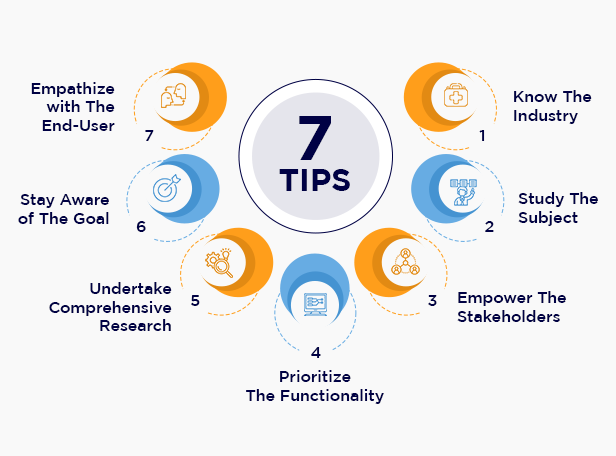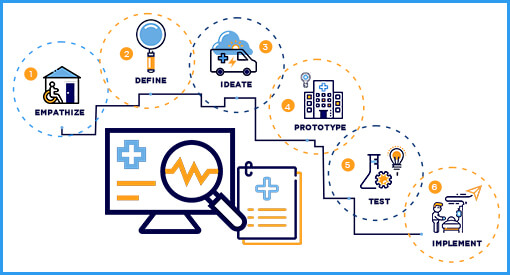As we set out to create an effective product for healthcare, the first order of business is to understand the needs of the healthcare industry. Fortunately, our expertise in healthcare software spans over decades. Medical professionals have specific needs, emergency rooms have unique requirements, and preventive care is optimized through intelligent mobile solutions. Not only are healthcare requirements specific, but each arena of the industry has its own unique needs.
Keeping this in mind, it was quickly realized that innovation is key. Primitive methods of product development are no longer adequate in bringing out the desired results. In our search for adaptive approaches, Design Thinking emerged as the clear winner. Adopting an innovative approach toward problem-solving through end-user-driven insights allows the development of a best-fit product. Prototyping and iterative refinement are critical factors in Design Thinking. We witnessed vast improvements in inpatient, provider, and customer satisfaction and a supreme advantage towards efficiency and collaboration.
Design Thinking is human-centric in its approach and operation. At the get-go, a problem is identified through interaction with end-users. The end-users insight and feedback are critical toward development and modifications. The next step is to creatively work on ideas and solutions, along with low-fidelity prototyping.
With a continually evolving healthcare panorama, technology and healthcare products have to follow suit. While developing a healthcare innovation product, it is imperative to streamline complex processes, maintain patient confidentiality, and manage the needs of healthcare professionals. During our journey of implementation and learning, here are 7 tips that will allow you to stay on course and successfully reach your destination.

Tip 1: Know The Industry
The US healthcare industry has its own specific and unique requirements, compounded by complex systems. Healthcare insurance is a complicated web with various plans and types that are defined by state laws. Restrictions on medical professionals that are covered under the insurance further complicate matters. On the other hand, the absence of insurance brings a whole plethora of complexities, including high costs and decreased accessibility. Product designers can start by understanding the specifics involved in the related healthcare innovation arena. Deep domain knowledge and understanding of the healthcare system at the starting point bring in a strong foundation toward product development.
Tip 2: Study The Subject
A product designer has the unique advantage of being the primary liaison between the product and the user. Holistic success is dependent upon product expertise and user knowledge. Understanding the role of the entity involved will play a significant part in successful product development. The designer will approach the development process from the perspective of the user. For example, providers are involved in delivering healthcare services. So, their products should be centered around simplifying healthcare delivery processes for higher patient outcomes or toward cost and time efficiency.
On the other hand, payers need products that enhance profit management, improve population health, cost of care, and revenue generation. Finally, if the users are patients, the designer should remain aware that their specific needs and expertise are limited. Understanding their goals is of paramount importance.
Tip 3 – Empower The Stakeholders
Design Thinking involves an innovative approach called empathy mapping, wherein the entire healthcare design team are aligned toward end-user experiences. As the developer comprehends the users’ motives, feelings, and aspirations, workflows are ideated and created. The product should be viewed as a means to improve workflow and enhance the specific process of healthcare. Stakeholders can be empowered by being pulled into this process. When stakeholders come from diverse perspectives, empathy mapping assists the entire team in having a unified and holistic approach toward decision-making.
Tip 4 – Prioritize The Functionality
Healthcare products are generally high-stakes. They affect patient health, treatment, and overall wellbeing. Errors and failures in functionality can have catastrophic consequences. Simplified usage and efficient functionality are critical success parameters. Complicated products are more prone to user errors. The designer must prioritize clear and simple technology renditions. Usability is another important factor that can go a long way in encouraging users to adopt the product. A clear interface, updated EHR, agile technologies, and optimized frameworks are some characteristics that contribute to a functional product.
Tip 5 – Undertake Comprehensive Research
Unlike other industries, healthcare entities are all inter-connected. What affects one affects all. Providers, payers, and patients rely on each other in more ways than one. Beyond that, patient and provider behavior and expectations vary across different populations and demographics. Comprehensive research, therefore, is crucial for success. For example, while developing a product for a hospital, the designer must factor in the expectations and needs of different departments for holistic satisfaction. Desk employees may require automated and fast-moving systems, while ER staff will need provisions for time management. During the process, incredible insights into the varied needs amount to a superior product.
Tip 6 – Stay Aware of the Goal
Along every step of the way, as a product designer, you must ask yourself – “What do I want to achieve through this product?” This will ensure that you stay on track all through the process. A clear understanding of the users’ needs, goals, and challenges is imperative to answer this question. Let’s use the example of a wearable device to track the fitness levels of patients. As a designer, start to think from the user’s perspective. What information will they need? What will they need to know? How much information would they be willing to divulge? To sum up, remember the ‘why’ and ‘who’ behind product development.
Tip 7 – Empathize with The End-User
Empathy is essential! An open and honest discussion of goals and expectations from the end-user forms the basis of Design Thinking. A fair understanding of the relative environment of operation is critical too. As a designer, you must gauge factors that will affect the functioning of your product. For example, are you developing a product that will be used round the clock or just during office hours? Will the user be on the go or stationary? Design requirements will vary based on these factors. Periodic testing in real-time will provide much assistance toward smooth functionality.
Conclusion
Design Thinking allows for developing a superior healthcare product that efficiently boosts patient satisfaction and the overall profit of a healthcare organization. Medical professionals are happier with optimized work processes, payers are happier with prompt payments, and patients are happier with better health outcomes. Overall, profit margins have the potential to rise exponentially.
A clear understanding and execution of the tips mentioned above can go a long way in improving patient, provider, and community experiences. Systematic and effective approaches are applied toward the result of higher revenue generation.
OSP is a trusted software development company that delivers bespoke solutions as per your business needs. Connect with us to hire the best talents in the industry to build enterprise-grade software.

How can we help?
Fill out the short form below or call us at (888) 846-5382
Looking for software solutions to build your product?
Let's discuss your software solutions for your product in our free development acceleration call!
Get In Touch arrow_forwardDiscuss Your Project Handover with a team of expert Book a free consultation arrow_forward
About Author

Written by Riken Shah linkedin
Riken's work motto is to help healthcare providers use technological advancements to make healthcare easily accessible to all stakeholders, from providers to patients. Under his leadership and guidance, OSP Labs has successfully developed over 600 customized software solutions for 200+ healthcare clients across continents.

















